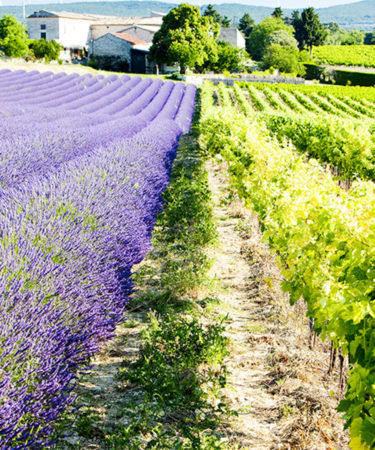Rosé is incredibly easy to drink. Not to suggest it is uncomplicated—there are complexities within the subtleties—but we could easily knock back a glass in less than 5 minutes. But before we all get to our seasonal pink wine chugging, we figured we should investigate rosé a little bit—specifically one of the most famous rosé-producing regions, Provence.
First there’s the fact that you kind of have to pronounce it like you’re some kind of posh know-it-all (Pro-vahns), But there’s a lot more to know about it, from it’s history, it’s climate, and yes, all those beautiful fields of lavender.
First of all, it’s called Provence because of some Romans.
Romans like to conquer things and rename them. The area that became “Provence” was known by the Romans as “Provincia Nostra,” literally meaning our province. A bit of a finders-keepers situation. Provence was actually one of the first established vineyard regions in France.
Provence has been producing wine for close to three millennia.
That bottle of Provençal rosé you just bought is part of a 2600 year history. The region’s been making wine since about 600 B.C., when the Ancient Greeks founded Marseille.
After the whole fall of the Roman Empire thing, monks took over winemaking.
Kind of like with Belgian beer, monks were actually the ones who kept winemaking traditions alive from the 5th to the 12th Century A.D., producing wine in order to fund their monasteries. And, presumably, kick back after a long day of monking.
Rosé makes up about half of all Provençal wine production.
Provence isn’t just about delicate rosés—the region also produces light (and dark) reds. But rosé makes up roughly half of all Provençal wine production. No surprise, roughly half of the rosé we drink in the United States comes from Provence.
In fact, we’re drinking more and more Provençal rosé.
Between 2010 and 2013, Provençal rosé exports to the U.S. more than tripled. And since 2015, rosé wine sales actually went up 60% compared to sales in 2014. Nor are the sales entirely relegated to warm weather seasons.
We’re also drinking a sh*t ton of one brand of Provençal rosé.
Chateau d’Esclans’ Whispering Angel makes up about 20% of all the Provencal rosé wine we drink in the U.S. Maybe it’s something to do with the slightly creepy saying on the bottle: “In the Esclans Valley, angels whisper. If you drink this wine, you might hear them.”
Chateau d’Esclans—makers of Whispering Angel—also produce the most expensive rosé in the world.
Most rosé is moderate in ABV (averaging 12%) and price, since rosé is more often intended to be an easy drinking, fresher wine (less contact with grape skin means lower tannins and generally much subtler flavors than you’d get with a red wine). But that doesn’t mean rosé can’t get up there in price. Garrus by Chateau d’Esclans currently tops out the list at around $90.
Yes, Brangelina is making a Provencal rosé.
It’s called “Miraval,” and it comes in a bottle that reminds us more of whiskey than wine. Supposedly getting some decent reviews, it clocks in at just around $20. Which is pretty affordable considering how much you spent on “Lara Croft: Tomb Raider.”
Don’t be fooled by appearances. Provençal rosé isn’t “light” on flavor.
One thing that distinguishes Provençal rosé is its lighter color—an incredibly delicate pink that can sometimes verge on clear. But that doesn’t mean Provençal rosé lacks complexity, largely thanks to the grapes used in its production—Grenache, Cinsault, and Mourvedre, to name a few. You can get anything from classic berry flavors to citrus notes, florals, bracing minerality, even spiciness.
Oh, and then there’s that whole special Provençal terroir thing.
Maybe you’ve seen a picture of some beautiful, lavender-carpeted Provençal hillsides. Herbs do abound in Provence, but they don’t really influence the flavors of the rosé. What’s much more essential to its terroir are the two major geological structures that make up the foundation of the region’s topography: limestone (and clay) and crystalline. And it doesn’t stop there. The general terroir is incredibly varied—mountains, gorges, coastline, and sloping hills. With, yes, all that lavender.
Provence even has a special wind.
Provence actually has several special winds, but the most famous one is called the Mistral, which carries cool air as it flows over the Alps. The most important thing about the Mistral is its dryness (excess humidity can be bad news for grape vines).
Provence is hotter than L.A. (Literally.)
Provence has a variable climate—very hot summers and colder, rainy winters—but one thing that’s consistent is the megawatt amount of sunshine it gets, approximately 2,900 hours per year (compared to just over 2,000 in L.A. and Miami). If you’re visiting in the summer, whip out the SPF 80.
If you’re drinking rosé straight out of the fridge, you’re doing it wrong.
Provençal rosé producers generally recommend their wines be chilled, but not frigid—anywhere from 45 to 55 degrees Fahrenheit. Your fridge is usually somewhere in the 30s, so take it out 15 to 20 minutes before you want to start chugging. Or delicately sipping. Whatevs.
